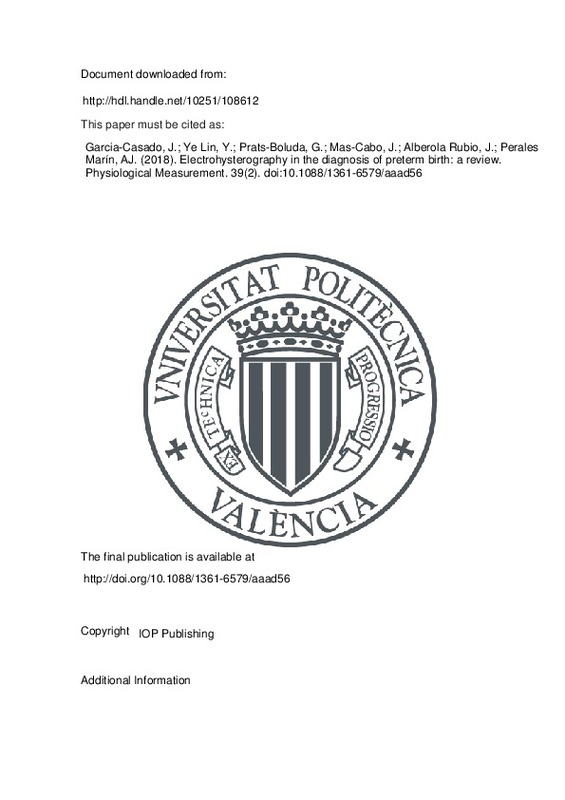JavaScript is disabled for your browser. Some features of this site may not work without it.
Buscar en RiuNet
Listar
Mi cuenta
Estadísticas
Ayuda RiuNet
Admin. UPV
Electrohysterography in the diagnosis of preterm birth: a review
Mostrar el registro sencillo del ítem
Ficheros en el ítem
| dc.contributor.author | Garcia-Casado, Javier
|
es_ES |
| dc.contributor.author | Ye Lin, Yiyao
|
es_ES |
| dc.contributor.author | Prats-Boluda, Gema
|
es_ES |
| dc.contributor.author | Mas-Cabo, Javier
|
es_ES |
| dc.contributor.author | Alberola Rubio, José
|
es_ES |
| dc.contributor.author | Perales Marin, Alfredo Jose
|
es_ES |
| dc.date.accessioned | 2018-09-29T04:31:02Z | |
| dc.date.available | 2018-09-29T04:31:02Z | |
| dc.date.issued | 2018 | es_ES |
| dc.identifier.issn | 0967-3334 | es_ES |
| dc.identifier.uri | http://hdl.handle.net/10251/108612 | |
| dc.description | This is an author-created, un-copyedited versíon of an article published in Physiological Measurement. IOP Publishing Ltd is not responsíble for any errors or omissíons in this versíon of the manuscript or any versíon derived from it. The Versíon of Record is available online at http://doi.org/10.1088/1361-6579/aaad56. | |
| dc.description.abstract | [EN] Preterm birth (PTB) is one of the most common and serious complications in pregnancy. About 15 million preterm neonates are born every year, with ratios of 10-15% of total births. In industrialized countries, preterm delivery is responsible for 70% of mortality and 75% of morbidity in the neonatal period. Diagnostic means for its timely risk assessment are lacking and the underlying physiological mechanisms are unclear. Surface recording of the uterine myoelectrical activity (electrohysterogram, EHG) has emerged as a better uterine dynamics monitoring technique than traditional surface pressure recordings and provides information on the condition of uterine muscle in different obstetrical scenarios with emphasis on predicting preterm deliveries. Objective: A comprehensive review of the literature was performed on studies related to the use of the electrohysterogram in the PTB context. Approach: This review presents and discusses the results according to the different types of parameter (temporal and spectral, non-linear and bivariate) used for EHG characterization. Main results: Electrohysterogram analysis reveals that the uterine electrophysiological changes that precede spontaneous preterm labor are associated with contractions of more intensity, higher frequency content, faster and more organized propagated activity and stronger coupling of different uterine areas. Temporal, spectral, non-linear and bivariate EHG analyses therefore provide useful and complementary information. Classificatory techniques of different types and varying complexity have been developed to diagnose PTB. The information derived from these different types of EHG parameters, either individually or in combination, is able to provide more accurate predictions of PTB than current clinical methods. However, in order to extend EHG to clinical applications, the recording set-up should be simplified, be less intrusive and more robust-and signal analysis should be automated without requiring much supervision and yield physiologically interpretable results. Significance: This review provides a general background to PTB and describes how EHG can be used to better understand its underlying physiological mechanisms and improve its prediction. The findings will help future research workers to decide the most appropriate EHG features to be used in their analyses and facilitate future clinical EHG applications in order to improve PTB prediction. | es_ES |
| dc.description.sponsorship | This work was supported by the Spanish Ministry of Economy and Competitiveness and the European Regional Development Fund under grant DPI2015-68397-R. | |
| dc.language | Inglés | es_ES |
| dc.publisher | IOP Publishing | es_ES |
| dc.relation.ispartof | Physiological Measurement | es_ES |
| dc.rights | Reserva de todos los derechos | es_ES |
| dc.subject | Preterm birth | es_ES |
| dc.subject | Electrohysterogram | es_ES |
| dc.subject | Uterine electromyogram | es_ES |
| dc.subject | Temporal analysis | es_ES |
| dc.subject | Spectral analysis | es_ES |
| dc.subject | Non-linear analysis | es_ES |
| dc.subject | Bivariate analysis | es_ES |
| dc.subject.classification | TECNOLOGIA ELECTRONICA | es_ES |
| dc.title | Electrohysterography in the diagnosis of preterm birth: a review | es_ES |
| dc.type | Artículo | es_ES |
| dc.identifier.doi | 10.1088/1361-6579/aaad56 | es_ES |
| dc.relation.projectID | info:eu-repo/grantAgreement/MINECO//DPI2015-68397-R/ES/ELECTROHISTEROGRAFIA, CONSTRUYENDO PUENTES PARA SU USO CLINICO EN OBSTETRICIA/ | es_ES |
| dc.rights.accessRights | Abierto | es_ES |
| dc.date.embargoEndDate | 2019-02-01 | es_ES |
| dc.contributor.affiliation | Universitat Politècnica de València. Departamento de Ingeniería Electrónica - Departament d'Enginyeria Electrònica | es_ES |
| dc.contributor.affiliation | Universitat Politècnica de València. Servicio de Alumnado - Servei d'Alumnat | es_ES |
| dc.contributor.affiliation | Universitat Politècnica de València. Instituto Interuniversitario de Investigación en Bioingeniería y Tecnología Orientada al Ser Humano - Institut Interuniversitari d'Investigació en Bioenginyeria i Tecnologia Orientada a l'Ésser Humà | es_ES |
| dc.description.bibliographicCitation | Garcia-Casado, J.; Ye Lin, Y.; Prats-Boluda, G.; Mas-Cabo, J.; Alberola Rubio, J.; Perales Marin, AJ. (2018). Electrohysterography in the diagnosis of preterm birth: a review. Physiological Measurement. 39(2). https://doi.org/10.1088/1361-6579/aaad56 | es_ES |
| dc.description.accrualMethod | S | es_ES |
| dc.relation.publisherversion | http://doi.org/10.1088/1361-6579/aaad56 | es_ES |
| dc.type.version | info:eu-repo/semantics/publishedVersion | es_ES |
| dc.description.volume | 39 | es_ES |
| dc.description.issue | 2 | es_ES |
| dc.relation.pasarela | S\354785 | es_ES |
| dc.contributor.funder | Ministerio de Economía, Industria y Competitividad | es_ES |







![[Cerrado]](/themes/UPV/images/candado.png)

